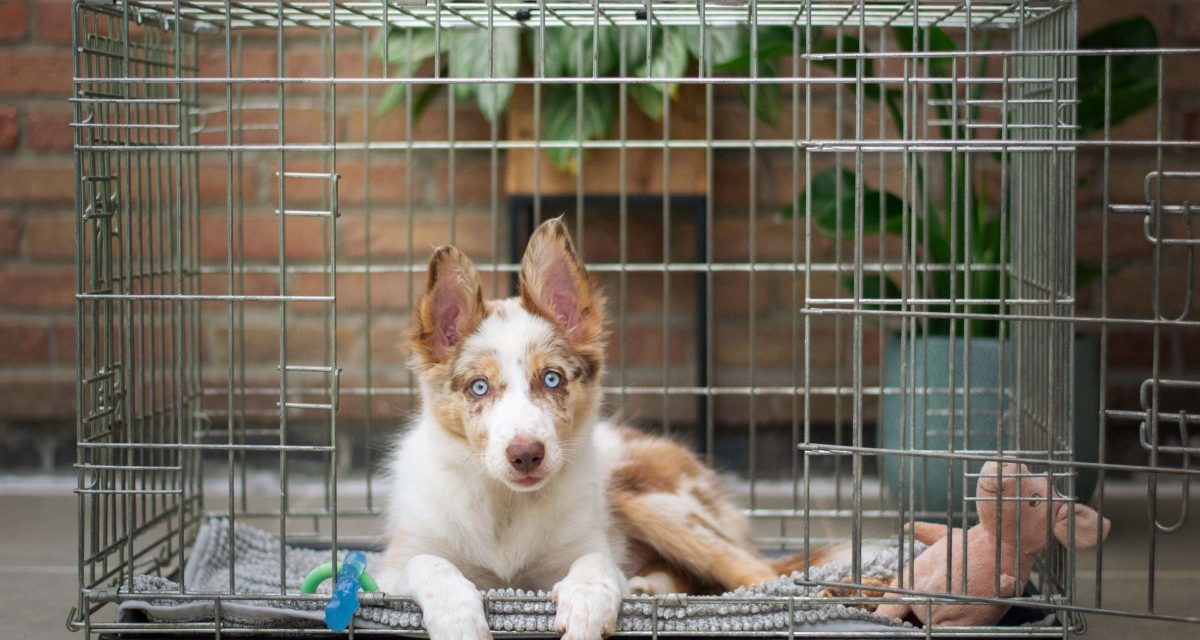Crate Training Your Puppy
Most people have heard of crate training but may not know what it really is or why it works. The following is a brief discussion about crate training, how to use it with your puppy, and some common mistakes made. Crate training takes time, effort, and a lot of patience, but when used properly, it can be a positive experience for both you and your dog.
Why should I crate train my puppy?
Crate training is a great way to limit your puppy’s access to your house while he learns appropriate behavior. It will cut down on the number of “accidents” while your puppy is learning to be housetrained, and will reduce destroying and chewing of furniture or other household items. It will give you more peace of mind and freedom to be away from home during your puppy’s growing up period. If your puppy is used to being crated it will also be easier and less stressful for him to travel, to be in a cage at the veterinarian, or to be confined for any other reason in the future. You may choose to continue to use the crate into your dog’s adulthood as his very own comfortable “room”.
Why does it work?
In the wild, dogs naturally seek out dens for sleeping quarters. Presumably this is because they are closed with only one entrance, giving the dog a sense of security. Dogs instinctively do not like to soil in their dens and will go outside to eliminate. Crating your dog is simply using his instinct not to soil in his den, and so therefore allowing you to gradually teach him that your whole house is his “den” and to only eliminate outside. Some people feel apprehensive about crating their dog, thinking that it is mean and that their dog won’t like it. However, since dogs seek out dens on their own, a crate is both natural and comforting to a puppy.
How do I choose a crate?
Both wire and plastic crates are available. Both work well, so it really depends on your personal preference. Keep in mind that plastic crates can be used for airline travel while wire crates may be collapsible, thus easier for storage. Getting the right size is very important. Your dog should be able to stand up and turn around freely in his crate, but it should not be big enough for him to have a separate toilet area. If your puppy is going to grow a lot more, get a crate that will be big enough for him as an adult, but block the back area so it is not big enough for him to have a separate toilet area now.
How do I crate train my puppy?
First, make sure the crate is comfortable by placing a towel or bed inside. Place the crate in a common area and put toys and treats inside for your puppy to discover. Don’t ever force your puppy into the crate, as going in should always be a positive experience. Praise him every time that he goes into the kennel. After he is comfortable going inside his crate for treats, beginning feeding his meals inside the crate. Start closing door while he is eating, but open it before he is
done. Next, leave the door closed for longer increments of time, building slowly. Never open door when he is whining or scratching, but only open it when he is quiet. If he is consistently whining, he is being closed in for too long, so go back to an amount of time he tolerates well and increase more slowly. After that, start crating him at other times besides his meals. Always give him an incentive to go into the crate (treats, food-filled toys, such as a Kong®, toy etc.). First stay in the room with him and then start leaving the room for short increments of time, building very slowly. Once he handles this well you can start leaving the house for short periods of time, again slowly increasing length of time. The length of time it takes for a puppy to learn varies from dog to dog, so remember that patience is key for your puppy’s success!
Problems and common mistakes:
- Crate too small or too big: If your puppy’s crate is too small, he will not be comfortable inside, and therefore crating will not be a pleasant experience for him. However, if it is too big, he can have a separate toilet area. If you purchase a kennel for him to grow into, make sure to block off the back portion to prevent this from occurring.
- Forcing puppy into crate: Forcing your puppy inside can be scary for him, making him associate crating with an unpleasant experience. Crates should NEVER be used as punishment. Always have toys or treats inside to have it be a pleasant, rewarding experience for him.
- Moving too fast: Baby steps are very important! Slow shaping of behavior is imperative for success.
- Leaving inside for too long: Even with proper training puppies need to go to the
bathroom frequently and can’t be expected to “hold it” for extended periods of time (eg. overnight, all day while at work). If your puppy is having accidents in the crate it’s most likely not his fault—he just needs to be let outside more frequently. - Whining: Ignore your puppy when he is whining or barking in crate. This means no positive or negative attention. Letting him out will train him that he can get out when he cries, and scolding him will be confusing or even rewarding to him since what he really wants is your attention!
- Using a crate to manage anxiety: If your dog has separation anxiety or other anxieties, crating him may stop your house from being destroyed, but it likely does nothing to decrease his anxiety, and it may make your dog even more anxious. For example, he may break his teeth trying to chew his way out or rip out his nails trying to dig his way out. If your dog has anxiety problems, you need to consult with your veterinarian. If you are having any problems crate training your puppy, see your veterinarian. While crate training is a great tool for most dogs, some dogs may require a more directed and personalized training approach to fit their learning styles. Your veterinarian may have some additional ideas or be able to refer you to a good animal behaviorist or trainer for more information.
Handout created as part of a class exercise by veterinary students:
Matt Owens and Julie Wetherell
Clinical Animal Behavior Service
www.vetmed.ucdavis.edu/vmth/small_animal/behavior
UCDAVIS VETERINARY MEDICINE





